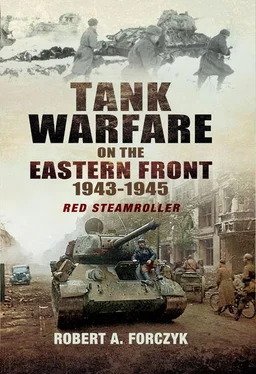A classic example of German inefficiency in tank production is the Nibelungenwerke in Austria, which was built from scratch between 1939–41 at the cost of RM 65.7 million and was intended to produce 150 Pz IV tanks per month in 1942. However, just as the plant was reaching initial operational capability (IOC) in January 1942, the OKH decided to escalate the long-dormant heavy tank program. The Nibelungenwerke was directed to work with Porsche in developing and building his VK 4501(P) Tiger prototype, while Henschel built its own VK 4501 (H) project. Despite the fact that Porsche’s design was plagued with technical problems, the Nazi hierarchy ensured that it was assigned higher priority than Pz IV production and the two largest workshops at the Nibelungenwerke were given over to Dr Porsche’s project. Enter Karl Otto Saur, Speer’s deputy in the Reichsminister für Bewaffnung und Munition . Saur was also an ardent Nazi and issued orders to both Henschel and Porsche that they would complete their prototypes for the Tiger competition by Hitler’s birthday on 20 April 1942. Remarkably, the Nibelungenwerke was able to meet this arbitrary schedule and assemble a single VK 4501(P) prototype, but this came at the cost of restricting Pz IV production to just 2–8 tanks per month for the first five months of the year. Adding insult to injury, Speer recognized that the VK 4501(P) prototype was technically unreliable and terminated the programme, awarding the production contract for the Tiger to Henschel instead. However, Porsche continued to be one of Hitler’s favourites, so he was handed a consolation prize: the Nibelungenwerke would build 90 VK 4501(P) hulls, which Porsche would convert into an as-yet-undesigned Ferdinand heavy tank destroyer. Just as the Nibelungenwerke was ramping up to build 32 Pz IV tanks in November 1942, the staff were informed that the Ferdinand now had top priority and assembly had to be completed by April 1943. Half the workspace of Workshop VII, intended for Pz IV assembly, was handed over to Porsche for his Ferdinand project. Consequently, thanks to Porsche and Saur’s Nazi cronyism, the Nibelungenwerke only built the miniscule total of 186 Pz IV tanks during 1942 instead of the 1,800 planned. The Ferdinand programme prevented any significant increase in Pz IV production for months and it was not until June 1943 that the Nibelungenwerke was able to raise its monthly output to 120 Pz IV Ausf H. Since the Nibelungenwerke was also responsible for producing spare road wheels for the Pz IV, this output was also significantly impaired until spring 1943. {27} Stalin never tolerated this kind of disruption of critical war production, but it was commonplace in the Third Reich.
Nor were the problems at the Nibelungenwerke unique. In addition to his faulty VK 4501(P) prototype, Porsche wanted to build a super-heavy tank and built a wooden prototype, which was demonstrated to Hitler, Guderian and other dignitaries on 1 May 1943. Porsche intended to build a 188-ton tank, mounting the new 12.8cm Pak gun. Guderian rejected this concept as ridiculous, but Hitler liked the idea and authorized a production run of 150 units, to be known as the Maus. Both Krupp and Alkett were ordered to provide production space and technical personnel to assist Porsche on his fool’s errand of constructing the largest tank in the world. Not to be left behind in the super-heavy field, Henschel began development of its own version of a 140-ton tank armed with a 12.8cm gun in June 1943. Indeed, Hitler was so impressed with the firing trials of the 12.8cm gun that he ordered that it should be mounted on a future variant of either the Tiger or Panther – this was despite the fact that the 7.5cm KwK 42 and 8.8cm KwK 36 were more than adequate to defeat Soviet tanks. Hitler’s whimsical decision meant that just as the Nibelungenwerke was ramping up Pz IV production after Kursk, it was ordered to devote resources to design and produce a new heavy tank destroyer, which would become the Jagdtiger. The ripple effect of Porsche’s unrealistic designs and Hitler’s love of ‘gigantic’ weapons hit the German tank industry hard throughout 1943–44, diverting resources from the production of proven designs in favour of experimentation gone wild.
As if Porsche’s experimentation was not a big enough distraction, most of the German tank plants were still operating well below capacity even after Stalingrad. In Kassel, the Henschel plant, the sole manufacturer of the Tiger tank, continued to devote two-thirds of its production space to the construction of locomotives, not tanks. While it was supposedly ramping up for full-scale production of the new Panther tank, the MAN factory in Nurnberg continued to produce trucks, because they were regarded as ‘essential for the company’s survival in the post-war economy’. Speer’s deputy, Saur, kept trying to get MAN to shut down its truck line in order to expand Panther production, but the company management just ignored him. {28} Heading into 1943, German manufacturing procedures were still not really geared toward mass assembly of tanks. Many businessmen were concerned that Hitler could shift armaments priorities on a whim – as he had decided to do at the start of Barbarossa in 1941 – and were reluctant to invest capital in developing excess production capacity in military factories when they were assured by the regime once again 1942 that victory was imminent. At mid-war, most German tank plants were still not operating at full capacity due to severe labour shortages and Speer was astounded that the main tank plants were not running a second shift. {29} Henschel was the first to institute two 12-hour shifts in late 1942 and by early 1943 Speer pressed the other companies into following suit. However, the only way to quickly add additional shifts was to boost reliance on foreign forced labor, including prisoners of war, which further reduced efficiency in the factories.
Another factor that hindered a significant increase in German tank production in 1943 was the over-engineered nature of German tanks and the finicky criteria retained by the Heereswaffenamt inspectors to evaluate completed tanks. For decades, most sources have claimed that the Tiger tank required 300,000 man hours to complete, or roughly double the time required to build a Panther. Yet other sources state that the Panther required 55,000 man hours, and another authoritative source states that a single complete Panther could be built in just 2,000 man hours. {30} In fact these numbers are over-simplistic, because the production rate of Panther tanks at various German factories varied considerably – there was no standard rate. However, by 1944 the MAN factory employed 4,483 employees directly involved in tank manufacture and assembly, who together spent roughly 1.6 million man hours per month on this task. Since MAN’s production of Panthers in 1944 topped off at 140–155 Panthers per month, this means than a single late-model Panther required at least 10,400–11,500 man hours to complete. {31} Obviously the early Panther Ausf D, plagued by technical faults, required many more hours than the late-run Panther, but the same could be said about the T-34 or any other tank. It is clear that as German tanks became more sophisticated after 1942, the amount of time and effort required to build just one of them greatly exceeded the amount of time and effort that Soviet industry needed to construct several T-34s. Even after Stalingrad, the Heereswaffenamt inspectors at the Nibelungenwerke were rejecting completed tanks due to ‘un-polished welds’ and ‘non-standard painting’ – i.e. for aesthetics. This kind of nonsense continued until mid-1943 until the Battle of Kursk, after which Speer pushed factories to expedite production by simplifying construction procedures and lowering standards; these changes resulted in much greater output in 1944. Yet based on the numbers from MAN, it is clear that even after Speer’s improved efficiencies, a Panther still required three times as much labour effort as a T-34 to produce.
Читать дальше








![John Stieber - Against the Odds - Survival on the Russian Front 1944-1945 [2nd Edition]](/books/405234/john-stieber-against-the-odds-survival-on-the-russian-front-1944-1945-2nd-edition-thumb.webp)



